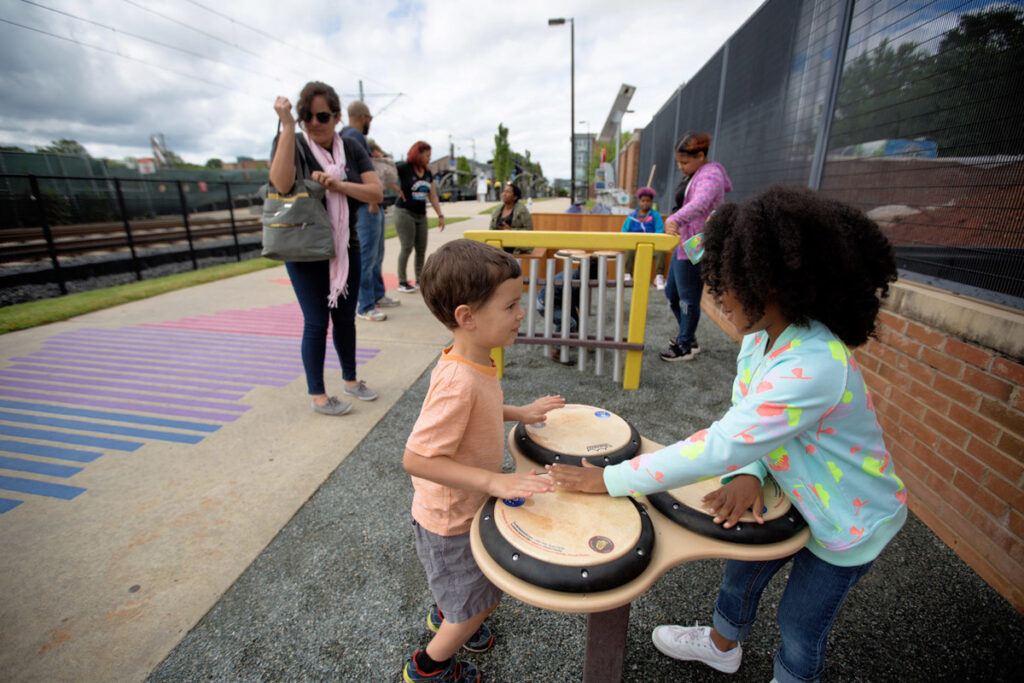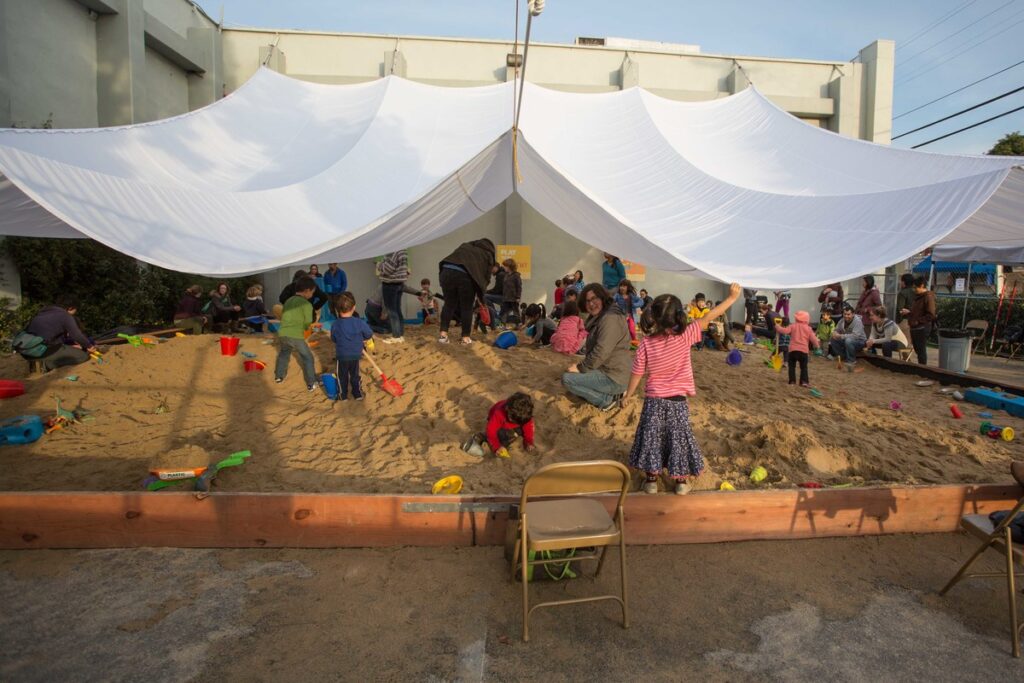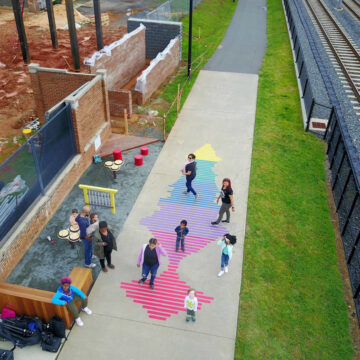For many families, going out to play is synonymous with “going to the park.” Yet, the reality is that parks— or at least the traditional idea of a neighborhood park with an enclosed playground— cannot by itself address the play deficit or integrate play into everyday routines for all ages and abilities. From a Play Everywhere perspective, bringing new opportunities to parks, open spaces and other public spaces requires a certain resourcefulness and ability to “think small” and see opportunities in overlooked spaces. It means activating and reclaiming underutilized and blighted spaces for playful uses, while putting kids’ imprints on spaces that, until now, have excluded them. It requires embracing public spaces in all their variety—large, small, tiny and linear; green and natural, hardscaped and constructed and publicly- and privately-owned. Finally, and crucially, it means thinking about play as a network of public spaces, rather than a single destination in a single park.

Design principles
Fostering Play Everywhere in parks, trails and public spaces entails thinking about play at multiple scales and in a variety of contexts. This includes:
- Bringing new life—and new play opportunities—to existing parks and public spaces.
- Carving out new spaces—even tiny ones—where the built environment, land uses and property ownership provide opportunities.
- Working with both public and private entities to create playful experiences, from which all can benefit.
Parks, plazas and trails
These are the larger, more established, open urban spaces. Some may already serve as places to play. Some may offer ample open space, yet lack adequate play facilities. Others may be established public spaces and open spaces, but are not thought of as places for kids and families: spaces for passing through, but not places for stopping, lingering and playing. Cities can take advantage of these spaces by:
- Incorporating play within existing park spaces as new, playful attractions within a park. In particular, consider locating play installations in parks where adequate play facilities currently do not exist or. Existing playgrounds can be complemented in large parks by locating playspaces in other parts of the park, so that more families in the surrounding area can have convenient access to play.
- Establishing playful routes and stopping points along internal park pathways, such as a painted mural or game on the pavement, or a play installation alongside the path.
- Activating existing park spaces with temporary or regularly-occurring park programming (see Moveable and Pop-Up Play for more ideas).
- Reimagining existing plazas or squares as focal points for play and multi-generational gathering places.
- Inspiring play “along the way,” by creating playful stopping points alongside existing trails, or utilizing the spaces along the edges of the trail alignment for play installations, murals and panels, or other playful nodes of activity.
Small public spaces
Meaningful play can fit into surprisingly tight spaces. The built environment is full of pocket parks or other small urban spaces that may not be large enough for a playground, yet offer many playful possibilities. Whether it’s a playable or climbable sculpture, a mural or hopscotch trail, play can bring new life to overlooked or neglected public spaces. It can also bring new pocket parks to life in unlikely places. In the built-out urban environment, where park land is limited or inaccessible to many neighborhoods, integrating play into smaller public spaces can be a powerful and impactful strategy. By bringing play closer to where kids and families live and conduct their daily activities, it becomes more equitable and convenient. Specific opportunities include:
- Activating existing pocket parks by using one or more play installations as the magnet or anchor that brings the space to life.
- Establishing new pocket parks in underutilized spaces by transforming a vacant lot into a playful oasis.
- Reclaiming large expanses of sidewalk, curb extensions or the verges along streets and sidewalks as playful pocket parks (see alsoStreets and Sidewalks).
- Repurposing excess or underutilized street space, such as traffic circles, wide medians and traffic/pedestrian-refuge islands, as small, but play-filled public spaces (see alsoStreets and Sidewalks).

Privately-owned public spaces
In cities across the country and around the world, a new form of public space has taken root: the privately-owned public space (sometimes referred to as “POPs”). These are public spaces that are privately owned, but are legally required to be publicly-accessible. Some of these spaces may be the plazas and courtyards that surround buildings on private property. Others may be indistinguishable in design and function from public parks or plazas, but are managed, operated and maintained by private entities using private funds. All such spaces may be subject to a different set of rules and regulations regarding what can and cannot occur in the space. Depending on the owner and associated land uses, this can present challenges to incorporating play if it is viewed as incompatible with existing uses and tenants on the site. On the upside, privately-owned public spaces offer unique opportunities. Property owners and managers may have the resources to build or program play; in fact, they may want to attract more families as customers to stores or restaurants or they may want to make residential properties appealing to families. Specific opportunities, in collaboration with property owners and managers, include:
- Incorporate playful activities within privately-owned parks and plazas, or retrofit the plazas and courtyards around buildings. Look for opportunities to complement and leverage existing private land uses, such as shopping, restaurants or residential uses, by integrating play into adjacent plazas, courtyards and open spaces.
- Partner with property managers, business improvement districts and other entities to establish playful programming at times when families are likely to frequent these destinations (see also “Moveable and Pop-Up Play” and “Commercial Spaces“).
General considerations
- Strive to fill the gaps in the network of playspaces. Understand the overall distribution of parks and playspaces across the city and individual neighborhoods to identify geographic areas and population centers that lack convenient access to a park or playground. Identify opportunities for intermediate spaces to connect the network and provide play opportunities closer to where people live or spend time.
- Analyze area demographics, land uses and mobility patterns to identify and target the parks and public spaces that are likely to have high volumes of traffic and bring play to those who need it the most.
- Build on what’s there already by observing existing patterns of how kids and families already use and play in park or public space. Kids may have already adopted certain spaces for informal play. There may be features that may not have been intended for play, but still attract kids, including water features, changes in topography, walls and ledges to navigate, statues to explore, trees to climb, interesting colors and textures or natural features to investigate.
- Design for flexibility, variety and accessibility to allow for multiple uses and functions within even the smallest of spaces. Quiet nooks for respite, seating for adults (consider moveable furniture for greater flexibility) and contact with nature can make the space attractive to all ages and abilities. When locating a playspace in a park that already contains one, consider ways to complement what already exists. Try providing play opportunities for a broader range of ages and abilities, or creating spaces that can help exercise kids’ bodies and imaginations in different ways.
- Embrace small spaces. Remember that playful interventions in the tiniest of spaces can inspire boundless inspiration and imagination. Meaningful play need not require large tracts of land; the corners, nooks and surfaces of the built environment can inspire wonderment as well.
- Make play visually accessible. Wherever possible, do not hide a play installation within a park or public space; rather, locate it at the edges or make it visible from surrounding streets by including an identifiable feature or landmark. When it must be out of sight, consider incorporating playful signs and wayfinding elements to attract attention and direct kids and families to the playspace.
- Acknowledge and activate the edges (but do not over-construct them). Strive for a sense of safety and enclosure, but design spaces that invite people of all ages and abilities into them. Seek out opportunities to activate or enliven the edges of a playspaces with complementary uses, such as outdoor seating for restaurants or cafes, a grocery store or convenience store, or even places to sit and gather. Locating playspaces adjacent to such uses creates a natural, but not overbearing, surveillance that establishes a sense of safety and security while giving kids and adults the option of engaging in separate activities within close proximity to one another.
- Consider the elements and all seasons. Strive for a mix of sun and shade; where possible, consider providing some form shelter. Understand when sunlight and shadows occur at different times of day, by making use of existing trees and noting the site’s wind patterns. Make play installations appealing at different hours, during different seasons and in all kinds of weather.
- Partner with private entities, such as property managers and business improvement districts, to activate privately-owned and creative playspaces with playful programming that benefits all users of the space.
